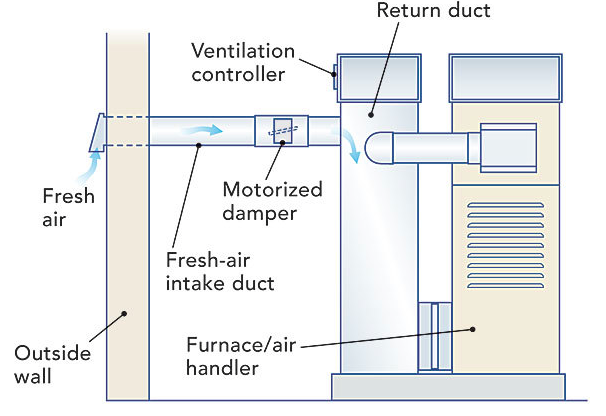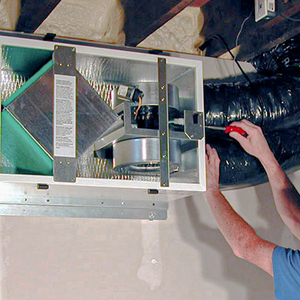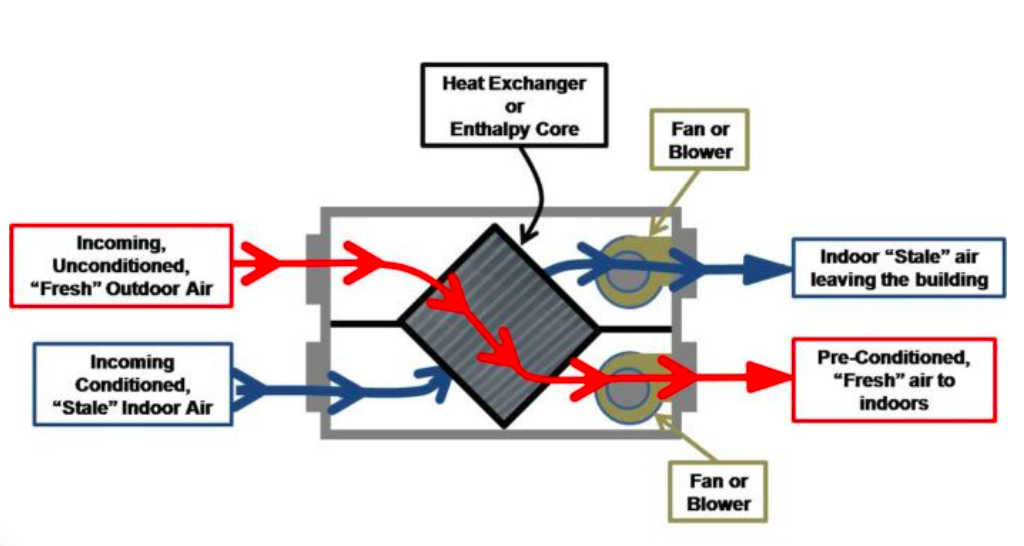Josh Oduin is in Leavenworth, WA, talking about adding an HRV for balanced ventilation in his new cabin. He walks us through his reasoning for choosing the Lunos E2 HRV over a typical ducted system. The Lunos E2 is a collection of simple components. Most of the work is done by a constantly reversing pair of fans and heat exchangers that eliminate the need for the complicated heat-transfer components found inside typical HRVs. Josh gives a brief overview of how the units work and demonstrates the basic steps of installation.
_________________________________________________________________________
Josh Oduin is a remodeler based in Portland, Oregon.
Weekly Newsletter
Get building science and energy efficiency advice, plus special offers, in your inbox.










18 Comments
Thanks for the informative video. I have been considering these Lunos HRV for some small studio apartments. Their relative simplicity and claimed efficiency is appealing. Some of my reservations are:
Price; about $1200 for the kit with tax and shipping. In an expensive labor market, the total installed cost probably ends up over $2k.
My understanding is that they are not a good substitute to bathroom or kitchen ventilation since the air flow is modest (10 to 20 CFM) and reverses every 55 to 70 seconds. So even for a small unit, I would be looking at 3 or 4 wall penetrations/unit.
As someone pointed out to me, how long can one expect a motor that stop and reverses every 55 to 70 seconds last? – that’s roughly half a million cycle per year if running constantly!
In a real world usage, I am a little dubious of the manufacturer’s claim of “Heat recovery efficiency: 90.6%”
If anyone who has used these for a few years would like to comment -on the reliability aspect in particular- I am happy to be proven wrong 😊
I'd be willing to wager a lot of money that the real world efficiency is well below 90%. They are almost certainly fudging with something like peak efficiency. Immediately after reversing flow, there is a certain amount of heat energy in the core. The longer the fan runs after that switch, the lower the temperature of the core, and the less heat you are recovering. The other trick they might be pulling is that instead of measuring total efficiency, they are just measuring the amount of heat captured by the core that is returned indoors, ignoring the fact that this energy return is on a 50% duty cycle. I suspect that the total efficiency of the system is in the ballpark of 45%.
In this era of inexpensive temperature monitoring, it should be possible to collect data and find out!
It's no surprise that Lunos would publish the numbers that make the product look the best, but how did we get from 90% to 45%? If the test protocol is understood (tested with DIN 308 / DIBt protocol), perhaps that could be explained?
"measuring the amount of heat captured by the core that is returned indoors, ignoring the fact that this energy return is on a 50% duty cycle." I'd be surprised. That says zilch about actual system efficiency and so would be a useless number.
It would be a useless number to a buyer, but it would be incredibly useful as a sales tool. It is common practice across many industries to use completely bogus numbers to advertise products. That's why it wouldn't surprise me.
I am speculating that they're fudging by looking at one fan at a time. I have no other basis for this than I don't believe their 90.6% number. It defies all logic. Let's take a look at some hypothetical numbers.
0degC outside, 20degC inside. In order for the device to be 90% efficient, the average air temperature has to be 18degC. If we imagine that we have the ports covered and the core starts at 20degC, as soon as air starts coming in, that core starts to drop in temperature. Let's say it drops to 16degC by the end of the incoming air cycle. This will give an average air temperature of 18degC, so 90% efficiency. So far so good. However, in order for this to be a sustained 90%, the core has to be able to recover 4degC in the same amount of time as it lost 4degC, except instead of an average 18degC delta, there is only an average 2degC delta. So it's not going to get anywhere close to the starting 20degC. Each cycle this imbalance in energy exchange is going to repeat, until the system reaches homeostasis. It seems kind of intuitive to me that the homeostasis point would be when the average core temperature reaches the midway point between inside and outside air, implying a theoretical maximum efficiency of 50%. Throw in losses and electrical power usage, and 45% seems about right. They could fudge this by time limiting the test, just for one example. And I could be completely wrong, all I know is that it seems fishy to me.
The core isn't just at one temperature. There's a temperature profile from inside to out. And the fans reverse soon enough that it stays pretty close to its steady-state temperature profile.
We agree that 3rd-party measurements would be best. Here's a third-party measurement of a different Lunos product, and they conclude that the manufacturer's data is accurate.
https://iopscience.iop.org/article/10.1088/1757-899X/1203/2/022045/pdf
I don't see that conclusion anywhere in there. Reading from the graph, what I see is that efficiency drops off a lot as flow increases; from about 88% at minimum fan power (7cfm) down to 64% at max fan power (53cfm). Note that doesn't account for energy used by the fan, so knock a few % off those for true efficiency. When you consider that the minimum flow rate on the E2 provides about enough fresh air for half a person or a medium sized cat, I think the efficiency at maximum flow rate is what we should be looking at (60%, if we assume it's similar to the model in the test). Even at maximum, the E2 isn't capable of ventilating even a bachelor pad apartment. You'd need 10 pairs of them to get the same flow as a medium sized conventional HRV.
Trevor,
Hey - let's leave my cat's weight out of this. It's Christmas after all.
I agree with your point, but isn't the 53 cfm more than enough for a cabin that sized using ASHRAE standards?
Malcolm,
The 54cfm max is for another model, not the E2. The E2 tops out at 35cfm.
I look at ASHRAE standards like code minimum insulation and air sealing. The difference is that non-optimal insulation levels can be compensated for by adding more heat, whereas if you undersize your ventilation you're pretty much stuck. Very few people would be willing to open windows in inclement weather, even if they were aware that the air quality is poor. The vast majority never know they have poor air quality.
Even if we accept the ASHRAE numbers as a guideline, it's bad practice to design a system that MUST run at 100% capacity to reach the minimum standard. When it comes to the Lunos, you can't have your cake and eat it too. Meaning if one of the touted features is a 90% efficiency and that efficiency is at <10cfm, you can't also tout the maximum flow rate of 35cfm.
The more I learn about the Lunos, the more it seems like a product suitable when you are desperate to get any amount of fresh air into an already existing space with logistical challenges. I don't see it as having any place in the design of a new building. The cost to performance ratio is horrible.
Trevor,
I agree.
Traditional ac powered induction motors are stressed by starting or reversing. But the electronic controls on a modern dc-brushless motor (also called an ECM) mean that that process is smooth and stress free. The reliability concerns are more if line transients kill the electronics or if they electronics run hot 24/7 and die from time/temperature effects. A whole-house surge protector is a good way to make the former highly unlikely, and these are small and low power, so they aren't likely to run hot, and being from a reputable manufacturer, I expect they use high-quality components that will last a long time.
We've had ours now for 7 years and love them. I've also put 8 pair in the homes I've made net zero and nobody has complained. Yes, I am a 475 fan. As we threw out the mini inverter and run it straight 12V from our PV system we expect it to last pretty much forever like our 30 year old variable DC water pump. I always do warn folks that they are not intended for use off a busy street as you can hear through them. We are on a very busy street but both are facing away and we don't notice a thing. They can start frosting up around -15F in high winds, but keep in mind here in GB WI we have 80% humidity down to -20%. Brrrr but we don't mind it. Go PACKS!
Oh, thank you for mentioning the noise aspect! I hadn't heard that as a factor before, but it makes perfect sense. I'm going to be installing a pair in the guest house I'm building and was planning on putting one of the units in the bedroom... but this neighborhood can be a cacophony of animal noises and all of my sound-reduction efforts in the bedroom would be negated by putting a unit there!
@JoshOduin - I built an almost identical building as yours in the same climate/zone. Using one pair of the same HRV's I'm concerned with the volume of air exchange. Per 475 the sizing should be right but I'm dealing with ~60% humidity indoors (while it's 16% outdoors). What's your experience, Josh? Enough ventilation?
@KurtGranroth - they do some noise. I have one in the bedroom and at the lowest speed the noise is ok but at medium or high fan speed it's a nuance. I would like to see the fan speed programable to run faster when not occupied. Plan on "hiding" them in a closet or a low-traffic area.
We have used these quite a bit in our modular homes, and they seem to work well. We like that they are a through wall solution that can be readily installed in the module without a lot of fussing around with ductwork.
That said, my question with these has always been, especially for an average or larger home, what role does the pressure differential within a house have on them? We often have 3, 4, or 5 pairs in a two story home, and it worries me that these can become holes for a much greater amount of air leakage than we think. Also, what happens when there are, say 3 pairs below the neutral pressure plane, and two more pairs above it? Does stack effect increase the outflow of the upper ones and the inflow of the lower ones in such a way that air in and air out (and therefore energy absorbed/released by the core) is no longer even, and the lower floor ones cool more and the upper floor ones heat up more? (in winter) This would seem to have pretty significant affects on the efficiency of the units.
Great question. It would be good for Lunos to publish curves of flow vs. static pressure, so you could calculate what it would do with a given stack effect pressure.
Yeah, one of the notable downsides to Lunos is the extremely lacking technical documentation... and unfortunately, the US-specific Lunos technical help at 475 Supply is almost-but-not-quite non-existent.
But yeah, it wouldn't even matter what the US-support is like if Lunos directly published the tech docs since math and graphs work well even if the docs were all in German.
Hi all,
I have a pair of E2 Lunos fans that will not be used on a project. I'm in California. Please let me know if you are interested in purchasing them, and I can provide the details. (I'm not sure where else to post this!)
Log in or create an account to post a comment.
Sign up Log in